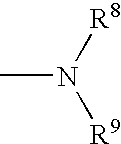Method of using and compositions comprising selective cytokine inhibitory drugs for the treatment and management of myelodysplastic syndromes
a technology of cytokine inhibitors and compositions, applied in the direction of drug compositions, peptides, angiogenin, etc., can solve the problems of variable risk of progression to acute leukemia, ineffective blood cell production, morphology and maturation, etc., and achieve the effect of prolonging the time of remission
- Summary
- Abstract
- Description
- Claims
- Application Information
AI Technical Summary
Benefits of technology
Problems solved by technology
Method used
Image
Examples
example 1
[0289] In a specific embodiment, prophylactic or therapeutic agents in an amount of about 400, 800 or 1200mg are administered in a cycle of about 24 weeks, about once or twice every day. One cycle can comprise the administration of a therapeutic on prophylactic agent and at least one (1), two (2), or three (3) weeks of rest. The number of cycles administered is from about 1 to about 12 cycles, more typically from about 2 to about 10 cycles, and more typically from about 2 to about 8 cycles.
example 2
[0290] The objectives of the study are to evaluate the efficacy and safety of oral administration of 3-(3,4-dimethoxy-phenyl)-3-(1-oxo-1,3-dihydro-isoindol-2-yl)-propionamide in patients with MDS. Patients receive the compound in an amount of 400 mg / d or 800 mg / d for 21 days every 28 days in 4-week cycles for 16 weeks (4 cycles) or 24 weeks (6 cycles). The subject population comprises patients with low- or interemediate-1-risk MDS (International Prognostic Scoring System) with red blood cell transfusion-dependent anemia who have received at least two units of RBCs within 8 week of baseline (first day of study treatment). In addition to hematological laboratory monitoring, bone marrow aspirates / biopsies with cytogenic analyses are obtained at baseline, after the completion of 3 cycles and after the completion of 6 cycles. The bone marrow, safety and efficacy data are reviewed to assess benefit-to-risk considerations throughout the study. The study reviews red blood cell transfusion i...
example 3
[0291] The objectives of the study are to compare the efficacy and safety of oral administration of 3-(3,4-dimethoxy-phenyl)-3-(1-oxo-1,3-dihydro-isoindol-2-yl)-propionamide to that of placebo plus standard care in patients with MDS. Patients receive the therapy in 4-week cycles for 16 weeks (4 cycles) or 24 weeks (6 cycles). The subject population comprise patients with low- or interemediate-1-risk MDS (International Prognostic Scoring System) with red blood cell transfusion-dependent anemia who have received at least two units of RBCs within 8 week of baseline (first day of study treatment). The study visits to assess safety and efficacy occur every 4 weeks and hematologic laboratory monitoring is performed every 2 weeks. Bone marrow aspirates / biopsies with cytogenetic analyses are obtained at baseline after the completion of 3 cycles and after the completion of 6 cycles. Bone marrow findings, safety and efficacy data are reviewed to assess benefit-to-risk considerations throughou...
PUM
| Property | Measurement | Unit |
|---|---|---|
| weight percent | aaaaa | aaaaa |
| weight percent | aaaaa | aaaaa |
| weight percent | aaaaa | aaaaa |
Abstract
Description
Claims
Application Information
 Login to View More
Login to View More - R&D
- Intellectual Property
- Life Sciences
- Materials
- Tech Scout
- Unparalleled Data Quality
- Higher Quality Content
- 60% Fewer Hallucinations
Browse by: Latest US Patents, China's latest patents, Technical Efficacy Thesaurus, Application Domain, Technology Topic, Popular Technical Reports.
© 2025 PatSnap. All rights reserved.Legal|Privacy policy|Modern Slavery Act Transparency Statement|Sitemap|About US| Contact US: help@patsnap.com



